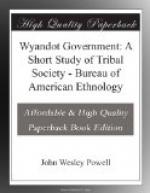Title: Wyandot Government: A Short Study of Tribal Society Bureau of American Ethnology
Author: John Wesley Powell
Release Date: October 25, 2005 [EBook #16947]
Language: English
Character set encoding: ASCII
*** Start of this project gutenberg EBOOK Wyandot government ***
Produced by Carlo Traverso, Barbara Tozier, and the Online Distributed Proofreading Team at http://www.pgdp.net, from images generously made available by the Bibliotheque nationale de France at http://gallica.bnf.fr.
[Transcriber’s Note: This text uses several diacritical marks: [)e] represents “e with breve,” [n] represents “superscript n,” ’ at the end of syllables is a prime mark, [u.] represents “u with dot below.”]
SMITHSONIAN INSTITUTION—BUREAU OF ETHNOLOGY.
J. W. Powell, director.
WYANDOT GOVERNMENT:
A short study of tribal society.
BY
J. W. POWELL.
In the social organization of the Wyandots four groups are recognized—the family, the gens, the phratry, and the tribe.
THE FAMILY.
The family, as the term is here used, is nearly synonymous with the household. It is composed of the persons who occupy one lodge, or, in their permanent wigwams, one section of a communal dwelling. These permanent dwellings are constructed in an oblong form, of poles interwoven with bark. The fire is placed in line along the center, and is usually built for two families, one occupying the place on each side of the fire.
The head of the family is a woman.
THE GENS.
The gens is an organized body of consanguineal kindred in the female line. “The woman carries the gens,” is the formulated statement by which a Wyandot expresses the idea that descent is in the female line. Each gens has the name of some animal, the ancient of such animal being its tutelar god. Up to the time that the tribe left Ohio, eleven gentes were recognized, as follows:
Deer, Bear, Highland Turtle (striped), Highland Turtle (black), Mud Turtle, Smooth Large Turtle, Hawk, Beaver, Wolf, Sea Snake, and Porcupine.
In speaking of an individual he is said to be a wolf, a bear, or a deer, as the case may be, meaning thereby that he belongs to that gens; but in speaking of the body of people comprising a gens, they are said to be relatives of the wolf, the bear, or the deer, as the case may be.
There is a body of names belonging to each gens, so that each person’s name indicates the gens to which he belongs. These names are derived from the characteristics, habits, attitudes, or mythologic stories connected with, the tutelar god.




